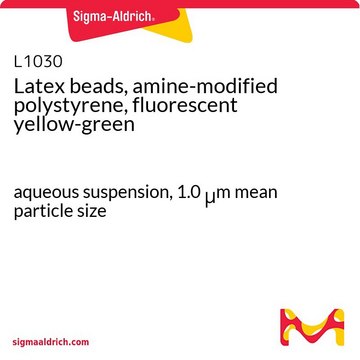Key Documents
P6407
Poly-ᴅ-Lysine Hydrobromide
synthetic, mol wt 70,000-150,000, powder, γ-irradiated, suitable for cell culture, BioXtra
Synonim(y):
PDL
About This Item
Polecane produkty
product name
Poly-D-lysine hydrobromide, mol wt 70,000-150,000, lyophilized powder, γ-irradiated, BioReagent, suitable for cell culture
pochodzenie biologiczne
synthetic (organic)
Poziom jakości
sterylność
γ-irradiated
linia produktu
BioReagent
BioXtra
Postać
lyophilized powder
masa cząsteczkowa
70,000-150,000
opakowanie
pkg of 10 X 5 mg
pkg of 5 mg
stężenie
0.016—0.032 mmol lysine
metody
cell culture | mammalian: suitable
pokrycie powierzchni
4 μg/cm2
zanieczyszczenia
<10% water (by Karl Fischer)
rozpuszczalność
H2O: soluble 50 mg/mL, clear, colorless
Warunki transportu
ambient
temp. przechowywania
−20°C
ciąg SMILES
O=C(C)[C@@](NC)([H])CCCCN.[Br]
InChI
1S/C6H14N2O2.BrH/c7-4-2-1-3-5(8)6(9)10;/h5H,1-4,7-8H2,(H,9,10);1H
Klucz InChI
MEXAGTSTSPYCEP-UHFFFAOYSA-N
Szukasz podobnych produktów? Odwiedź Przewodnik dotyczący porównywania produktów
Zastosowanie
- as a coating for plates used in culturing rat glial precursor cells (RGPCS).
- in coating flasks and plates in culturing tanycytes
- in preparing the surface of coverslips for facilitating cell attachment
This product is recommended as a cell culture substratum when using 0.5 - 1.0 mL of a 0.1 mg/mL solution to coat 25 cm2. Lower molecular weight versions of the product are less viscous, but high more molecular weight versions provide more attachment sites per molecule.
Działania biochem./fizjol.
Cechy i korzyści
- Sterilized using gamma (γ) radiation.
- Sterile Poly-D-Lysine solutions can be stored for three years when stored at 2-8˚C.
Komponenty
Przestroga
Uwaga dotycząca przygotowania
produkt podobny
Kod klasy składowania
11 - Combustible Solids
Klasa zagrożenia wodnego (WGK)
WGK 3
Temperatura zapłonu (°F)
Not applicable
Temperatura zapłonu (°C)
Not applicable
Środki ochrony indywidualnej
Eyeshields, Gloves, type N95 (US)
Certyfikaty analizy (CoA)
Poszukaj Certyfikaty analizy (CoA), wpisując numer partii/serii produktów. Numery serii i partii można znaleźć na etykiecie produktu po słowach „seria” lub „partia”.
Masz już ten produkt?
Dokumenty związane z niedawno zakupionymi produktami zostały zamieszczone w Bibliotece dokumentów.
Klienci oglądali również te produkty
Produkty
Poly-Lysine enhances electrostatic interaction between negatively-charged ions of the cell membrane and positively-charged surface ions of attachment factors on the culture surface. When adsorbed to the culture surface, it increases the number of positively-charged sites available for cell binding.
Poli-lizyna zwiększa wiązanie komórek z dodatnio naładowanymi jonami powierzchniowymi, optymalizując interakcje elektrostatyczne na powierzchniach hodowli w celu zwiększenia przyczepności komórek.
Cancer stem cell media, spheroid plates and cancer stem cell markers to culture and characterize CSC populations.
Extracellular matrix proteins such as laminin, collagen, and fibronectin can be used as cell attachment substrates in cell culture.
Protokoły
Poly-L-Lysine Cell Attachment Protocol
Przyleganie komórek do stałych podłoży za pomocą poli-lizyny, która wzmacnia elektrostatyczne oddziaływanie między ujemnie naładowanymi jonami błony komórkowej a powierzchnią hodowli.
Nasz zespół naukowców ma doświadczenie we wszystkich obszarach badań, w tym w naukach przyrodniczych, materiałoznawstwie, syntezie chemicznej, chromatografii, analityce i wielu innych dziedzinach.
Skontaktuj się z zespołem ds. pomocy technicznej








